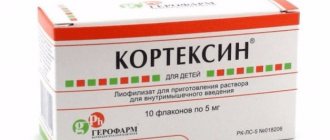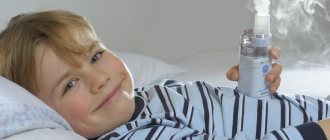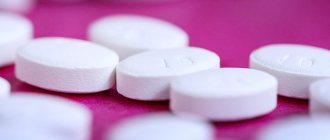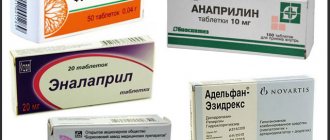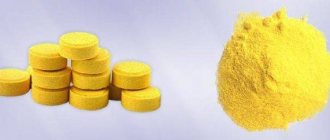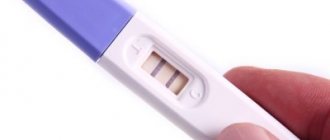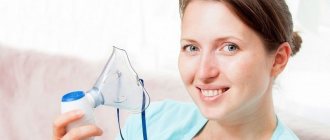Hello, dear readers of my diary! In this article, I will tell you what a nebulizer is and how to properly inhale a child to prevent a cold when the first signs of the disease appear.
When children get sick, this is a real test for mothers and grandmothers. It is very difficult to see how a small child coughs non-stop or how difficult it is for him to breathe through his nose or how he cannot eat because his throat hurts.
It is clear that it is better to try to prevent such types of diseases than to treat them later with the use of drugs and antibiotics. For us, such a salvation was the use of a nebulizer inhalation device, with the help of which my daughters and I prevent colds in our children.
Inhalation for adults
The inhalation procedure can be recommended both for treatment and as a disease prevention. It can be different and used in therapy at almost any age. It is enough to strictly follow the instructions and recommendations of the doctor, understand the principle of action and follow safety rules in order to achieve the maximum therapeutic effect.
Inhalation can help relieve inflammation, improve immunity, blood and lymph circulation in tissues. The procedure is prescribed for diseases of the lower and upper respiratory tract, including sinusitis, tonsillitis, influenza, and laryngitis.
Inhalers are actively used by patients with bronchial asthma, cystic fibrosis, and chronic obstructive bronchitis. Also, as a complex treatment, inhalation can be prescribed for respiratory complications due to HIV and postoperative complications.
Inhalations are also used in the beauty industry, because hot steam can rejuvenate the skin, cleanse it, nourish and moisturize it. In this case, steam devices with a “sauna” attachment, which is a face mask, are used. Fill the inhaler with special solutions with herbal infusions, essential oils and various medicinal products. Cosmetic inhalation can be therapeutic, cleansing and tonic. If a person is diagnosed with hyperthermia, arrhythmia, severe diseases of the respiratory system, heart failure and dermatological diseases that appear on the skin of the face, then cosmetic inhalations will have to be abandoned.
Inhalation during pregnancy
During the period of gestation, as in all other cases, inhalations can be done only as prescribed by the attending physician. A competent physician will help you choose an inhalation device (compressor, ultrasonic or steam inhaler), taking into account the expectant mother’s individual contraindications, chronic diseases and possible risks, the doctor will note absolute and relative contraindications for performing the procedure. According to statistics, it is most convenient to use a nebulizer.
It is better not to use steam inhalations using iodine, potatoes, saline and soda solutions, garlic, honey, because such dubious alternative medicine recipes may not only not bring the long-awaited effect, but also negatively affect the health of the expectant mother and fetus.
What are the advantages of inhalation
A procedure such as inhalation ranks high among other methods of treating respiratory diseases. For example, if we compare this method with tablets and syrups, it has significant superiority:
- The sprayed drug reaches almost the entire surface of the mucous membrane, through it it is quickly absorbed into the blood, and thanks to this helps a rapid recovery.
- Medicinal substances act directly on the sore spot, unlike tablets or syrups, which travel a long way through the stomach and intestines before reaching their destination.
- Thanks to this procedure, the respiratory system is cleansed.
Inhalation for children
One of the most ancient healing manipulations is inhalation. The range of applications of such a treatment procedure is huge, but in the last few decades it has been actively prescribed for respiratory diseases of varying severity. If a child is sick, he is tormented by a cough, runny nose, and the illness does not go away, most likely the attending physician will prescribe therapeutic inhalations. Previously, hardware inhalations were available only in medical institutions. Today, technology does not stand still, and every family can purchase, for example, a nebulizer for home use.
The effectiveness of inhalation is due to the fact that the medicinal solution can act directly on the problem area - the oral cavity, bronchi, throat, lungs.
Inhalations for children may be different. There are several most common recipes:
- Salty mineral water.
- Herbal infusions.
- Solutions with the addition of essential oils.
Any inhalation for a child should be carried out taking into account simple rules, especially since all procedures of this kind are performed according to the same principle.
- It is important to explain to the child how to behave during such procedures. This is the only way to achieve maximum effectiveness from therapy.
- You should not force your baby to breathe very often, even if he agrees to follow your instructions. The child may feel dizzy.
- Do not inhale immediately after eating.
- You cannot independently prescribe or increase the dosage recommended by your doctor.
- After the procedure, allow the child to rest.
If the child does not want to be treated with inhalations, then the parents will have to try and correctly explain to the child about the importance of the procedure. Of course, it won’t be difficult to persuade school-age children and teenagers; they already understand the word “need”. But what to do with a very small child who, for example, was frightened by a large noisy inhalation device and simply became stubborn?
Inhalation for a child should not be a punishment. It is necessary to explain to the baby what exactly the inhaler does and how the whole process occurs, because such a medical procedure should not be a surprise or shock.
Let the child press the nebulizer button himself, for example, when he does not yet have a ready-made solution for inhalation. Such actions will help the baby relax at least a little and develop a sense of control over the entire process. The child can help prepare the solution. It is important to create a comfortable psychological environment before inhalation; you should not shout at the child. In addition, do not forget that treatment of children must be carried out under the supervision of adults.
When to inhale: before or after meals
Indeed, not only the composition and characteristics of the active substance are of no small importance, but also the time of the procedure. For inhalations to work well and for you to get the maximum effect from the procedures, they must be performed at the right time, before or after meals.
When should inhalations be carried out - before or after meals:
- Many people are interested in the question: what should be the time intervals between meals? There are certain standards that should be followed when performing inhalation. It is best if you start the event an hour and a half after eating.
- This is due to the fact that if steam inhalations are performed, then you have to sit in front of a pan with a boiling solution in an uncomfortable way, and parts of the abdomen are pinched.
- Accordingly, if you carry out manipulations immediately after eating, you may experience heartburn, nausea, or the reflux of a small amount of gastric juice into the throat, which will cause an unpleasant burning sensation and painful sensations. If inhalation is carried out using a nebulizer, this does not mean that the time frame can be reduced.
- The minimum time is an hour after eating. It is best if it is extended to one and a half hours.
Nebulizer
Types of inhalers
Today there are several types of inhalers. In addition, the speed and quality of drug delivery to the body will depend on the type of device. The age of the patient and the presence of chronic diseases also play an important role. And thanks to knowledge of these nuances, the effectiveness of a particular treatment is determined.
Inhalation can be carried out using aerosol-type metered-dose inhalers, devices operating on the steam principle, thanks to ultrasound or electronics. Aerosol inhalation devices allow you to carry out procedures using medications, oils, herbal decoctions and even alkaline solutions.
An inhaler operating on the steam principle most often has a special temperature indicator and a heat regulator, thanks to which the medicine can be heated. Among the advantages of the device are low cost, as well as ease of operation. This inhaler can be used to humidify the air in a room or aromatize it, and a special attachment in the form of a mask allows you to perform cosmetic procedures. Among the disadvantages of the steam apparatus are:
- Risk of burns.
- Weak therapeutic effectiveness due to the fact that the microparticles formed during the operation of such an inhaler have a size close to 5 microns or more. They cannot penetrate the lower respiratory tract.
- An insignificant concentration of medicinal substances is determined in the vapor cloud.
An ultrasonic nebulizer crushes medications using vibrations of ultrasonic waves. The temperature regime of the aerosol has optimal indicators - from 33 to 38 degrees. The air flow of the inhaler can have different speeds, the indicators vary from 2 to 20 l/min. Ultrasonic inhalers operate almost silently, they have compact shapes and allow precise dosing of the amount of medicinal substances. Such devices are safe and convenient, eliminating the risk of burns. They can be used as aromatherapy or a humectant.
Various medications are used for inhalation, these can be anti-inflammatory drugs, secretolytics, bronchodilators, etc. If inhalation is prescribed to a patient in a medical facility, then the procedure is carried out in a separate, specially equipped room.
Metered inhalation technique
A portable metered dose aerosol inhaler is essential if inhalation into the respiratory tract must be carried out using glucocorticoids and/or bronchodilators. In order for the therapeutic effect to be maximum, it is important to adhere to the rules of technique for performing the procedure. In addition, the help of people (including medical workers) is not needed. This inhalation is performed independently, and even a child can perform it.
The technique is simple:
- take the canister in your hand so that the bottom of the inhaler is at the top;
- remove the cap;
- shake the can;
- exhale;
- tilt your head back a little and wrap your lips around the mouthpiece;
- press the inhaler while taking a deep breath (the timing is important);
- hold your breath (5-15 seconds) at the very peak of inhalation so that the medicine spreads well through the bronchi;
- exhale slowly.
Repeat the procedure after a few minutes. The dosage of inhalations is determined individually (depending on the age of the patient and the reasons for which inhalations are prescribed).
Features of the procedure for pregnant women
Inhalation at home for pregnant women with a runny nose is carried out with some peculiarities. While expecting a baby, the expectant mother tries to follow a daily routine and avoid illnesses, but a runny nose catches up with almost everyone. It is dangerous because it causes a lack of oxygen, which can harm the baby. Inhalation is the safest method of treatment, which has limitations:
- Do not use drugs to which you have an allergic reaction or a predisposition to it.
- During pregnancy, it is forbidden to use essential oils: cypress, rosemary, cedar, dill, nightshade, marjoram.
- When carrying out the procedure, iodine should be excluded from the list of ingredients used.
- General contraindications also apply to pregnant women; inhalation should be avoided if you feel unwell.
Prolonged inhalation technique
Inhalation can also be prolonged. Preschool children undergo such procedures with parental assistance. The baby is placed on his lap or wrapped in a blanket so that his hands are fixed. Teenagers and adults use this type of inhalation independently, wrapping their lips around the atomizer and inhaling. The duration of the manipulation takes about 7-12 minutes. The use of disposable mouthpieces is allowed.
Inhalation should be carried out no earlier than 60 minutes later. after eating or physical activity. If inhalation is prescribed for a runny nose, then it is advisable that the patient take vasoconstrictor drugs prescribed by the attending physician before the procedure. When inhaling, both a child and an adult must inhale deeply, swallowing air through the mouth and exhaling through the nose. It is important to hold your breath after inhaling for a few seconds.
After the inhalation procedure, doctors advise not to drink or eat food for 60 minutes. If the treatment was carried out with hormones, then on the contrary, it is advisable to rinse the mouth with clean water heated to 18-24 degrees. A course of prolonged inhalation therapy can consist of 4-16 procedures, depending on the problem and age of the patient.
It is important to know that if inhalation is prescribed for a preschool child, then strict control is necessary to eliminate possible errors during the procedure. It is desirable that the air temperature in the room where inhalation is performed is optimal - 18-21 degrees. The room must be well ventilated, otherwise there is an increased risk of allergies.
It is also necessary to control the temperature of the aerosol. Doctors say that the best absorption of drugs is observed at 36-37 degrees, and under such conditions the natural function of the ciliated epithelium is not disrupted. Inhalations with solutions that are too cold can cause irritation of the respiratory tract and even cause paroxysmal coughing.
According to statistics, many medical institutions in Russia over the past 10 years have abandoned various inhalations, including some herbal decoctions, vitamins, menthol oil and even antibiotics. This fact is connected, first of all, with the insignificant effectiveness of these funds.
Interestingly, fusafungine is especially popular in modern medicine. This drug is an antibiotic that also has an excellent anti-inflammatory effect. The medication is prescribed for laryngitis, bronchitis, sinusitis, rhinitis, as well as tracheitis and tonsillitis. Adults are recommended 4 inhalations through the mouth or nose (every 3.5-4 hours). Children are prescribed the same dose, but every 6 hours. The course of therapy is no more than 9-10 days. Contraindications include age under 2.5 years and any risk indicating the development of laryngospasm.
Useful tips
Inhalations are a simple and affordable method of treatment. However, it is important to ensure that the procedure is carried out accurately. Please pay attention to the following recommendations.
- If you prefer to use a nebulizer, then keep in mind that it is prohibited to pour oil into it (this will lead to side effects and deterioration of well-being) or decoctions of medicinal herbs (the likelihood that the device will become clogged and malfunction increases).
- Inhalations are performed standing or sitting. If you inhale hot steam, try to stay a short distance from the container so as not to burn your eyes.
- If you dilute the medicine with saline, do it a couple of minutes before the start of inhalation. Do you have any diluted and unused medication left? It is not worth storing it or using it.
- If your baby has been prescribed steam treatments, try to protect him from possible burns. Strictly ensure that the temperature of the liquid is no more than 40-60 degrees (additionally, consult a doctor).
- When you finish inhalation, wash your child and make sure he rinses his mouth thoroughly. If he is still small and cannot cope on his own, then you need to give him water to drink.
- Eating is allowed only thirty to forty minutes after inhalation. It is also worth preparing for the procedure itself. Do not eat for one to two hours.
By following these tips, you guarantee a speedy recovery and the absence of any side effects.
Inhalation with a nebulizer
Nebulizer treatment is one of the most effective, because it ensures precise delivery of drugs to the respiratory tract. This type of device is also called a compressor inhaler. It converts a liquid medicinal mixture into a fine aerosol due to ultrasonic influence or gas exposure. The sprayed medicinal solution has particles with a diameter of no more than 5 microns.
Nebulizer inhalations are prescribed from 2 years of age. This therapy does not require special coordination of breathing.
- As for bronchodilators that are prescribed for this treatment, it is worth highlighting combination drugs, as well as anticholinergics and P2-adrenergic agonists separately. Among the bronchodilator drugs (used for asthma) we can note: Salgim, Atrovent, Berotek, Steri-Neb salamol, etc.
- For rhinitis, pneumonia, pharyngitis, tonsillitis and even cystic fibrosis, nebulizer therapy with mucolytics and/or drugs that remove phlegm is prescribed. This could be Bisolvan, ACC, Lazolvan or Mucomist.
Inhalation with a nebulizer can be prescribed with the use of antifungal drugs, antiseptics and even anti-tuberculosis drugs. If antibiotics are prescribed during therapy, it is important to determine the sensitivity of the pathogenic microflora. Treatment with antibacterial medications through inhalation can take 5-10 days.
Initially, a small dose of medication is injected into the respiratory system using aerosol therapy. A test inhalation allows you to determine the level of antibiotic tolerance in a particular patient.
Among the negative characteristics of the nebulizer it is worth highlighting:
- High price of the device;
- The need for constant cleaning of the device;
- A small number of solutions that are intended for it.
Devices for inhalation therapy of bronchial asthma
In bronchial asthma, inhalation treatment plays a special role. In this case, modern nebulizers, powder inhalers, and metering aerosol devices are used to administer drugs into the respiratory tract under pressure. If the medication is a powder, then the easiest way to deliver it into the respiratory tract is with the help of cyclohaler.
It is convenient to use inhaled aerosol medications with compact spacers in the treatment of bronchial asthma in both children and adults. Such an auxiliary device helps the medicine penetrate deeper and simplifies the inhalation technique.
Inhalers, which allow medications to be delivered into the respiratory tract in powder form, can be different. The most common ones are inhaler, dischaler, spinhaler, etc.
Inhalations for runny nose and cough
The most effective cough inhalers are compressor, ultrasonic and electronic mesh devices, because they create small aerosol particles, which in turn can penetrate and settle in the lowest parts of the respiratory system.
Inhalations are prescribed for various types of coughs in order to significantly alleviate the course of the disease and reduce the manifestation of symptoms.
- If the cough is prolonged and debilitating, cough medicines and solutions that have a moisturizing effect are prescribed. A few days after such treatment, inhalations with antiseptic solutions, as well as mucolytics and antibiotics are recommended.
- If the cough is wet and sputum is discharged, then in addition to bronchodilators, antiseptics, mucolytics and solutions with a moisturizing effect are prescribed. It is advisable to use immunomodulators only against the background of a long-term cough that lasts more than 20 days.
Considering the information described above, we can confidently say that each individual situation requires its own individual treatment. And if the doctor prescribed one list of medications for a dry cough, then if the clinical picture changes, the therapy will need to be changed or simply supplemented.
Inhalations for coughs and runny noses can be recommended by a doctor for: rhinitis, tonsillitis, ARVI, pneumonia, bronchial asthma, laryngitis, bronchitis, sinusitis and pharyngitis.
Inhalation for a runny nose can be a solution:
- with sea salt;
- with alcoholic infusion of calendula;
- with anti-inflammatory drugs or antibiotics;
- with vegetable oils, including olive.
But you shouldn’t self-medicate, because even seemingly banal nasal congestion can indicate much more complex health problems, for example, sinusitis. But such a disease cannot be eliminated with one inhalation; complex treatment with the use of potent medications is necessary. In addition to all that has been said, it is worth noting that inhalations for a runny nose, which appeared as a result of allergies, can aggravate the patient’s condition.
Home inhalations
One of the most common therapeutic procedures is inhalation. It can be carried out at home or in special rooms of medical institutions. It is this method of treatment that can help eliminate the first symptoms of ARVI, in particular a runny nose.
Inhalation is considered an effective method of targeted treatment, because the medicine penetrates directly into the place where inflammation appears and infection develops. The sprayed medicinal solution is absorbed through the mucous membrane and begins to act quickly.
Home inhalation is practiced most often. This procedure can be performed in several ways: using special devices - inhalers, through a kettle or over a pan. It is hardware inhalation that is considered the most effective and safe.
You can carry out home inhalations with herbal decoctions, essential oils, mineral water or onions and garlic. But this can only be done on the recommendation of a doctor, because many alternative medicine recipes not only do not provide any therapeutic effect, but also significantly harm health.
For home inhalations, pharmaceutical chamomile, dried eucalyptus leaves, mint, linden flowers, St. John's wort, wild rosemary, calendula and sage are often used.
There are several popular recipes, for example, which are used for bronchitis:
- To improve the process of expectoration, you can make a solution of elderberry flowers and eucalyptus leaves. It is enough to take 20 g of these components and pour boiling clean water (0.5 l) over them. After the infusion has cooled to a temperature of 37-38 degrees, add 3-5 g of fresh Kalanchoe juice.
- Anti-inflammatory inhalation can be obtained using a simple recipe with the addition of onion juice, garlic and water (1 tsp per 0.5 water).
It is important to know about the dangers that may lurk in seemingly harmless home inhalation:
- Under no circumstances should you inhale boiling water steam. Any solution for inhalation should correspond to the approximate temperature of the human body. These are optimal indicators to exclude burns to the oral cavity or upper respiratory tract.
- You cannot carry out the inhalation procedure immediately after eating. This treatment may cause nausea, vomiting, or simply heartburn.
- It is advisable to take into account the fact that a decoction or infusion prepared at home can cause an allergic reaction. Therefore, it is advisable to perform the first inhalation on a trial basis; a few minutes will be enough.
- Inhalation should not be performed if the patient has an elevated body temperature, frequent nosebleeds are diagnosed, the person suffers from heart failure or has problems with blood pressure.
Doctors also recommend adhering to a few more simple rules to ensure the procedure is safe and most effective:
- it is necessary for the patient to remain calm; during inhalation, sharp breaths can only cause harm;
- It is not advisable to eat, sing, or scream immediately after inhalation.
If you need to buy an inhalation device for home use, experts advise taking into account the following facts:
- It is advisable to purchase an inhaler at a pharmacy or specialty store that offers certified medical equipment with a guarantee. Get advice from a doctor and sales consultant in advance.
- It is important to check the device for functionality when purchasing.
- You should not purchase devices that have already been used. Pathogenic microorganisms could colonize the inner or outer surface of the inhaler, which significantly increases the risk of infection in healthy people during subsequent use.
- Do not buy inhalation devices that are too cheap. The modern market offers a huge number of devices, but if you pay too little, you risk purchasing either a fake or a faulty product.
Inhalations with medicinal solutions
Therapeutic solutions for inhalation for colds and acute respiratory viral infections are different:
- Water with salt and soda;
- With medications;
- With medicinal herbs.
Just go to the pharmacy and on the shelves you will see a lot of medications made for inhalation. However, this does not mean that you need to take the first one you come across and go home for treatment; even inhalations with Borjomi for coughing require prior consultation with a doctor. Only a qualified specialist will establish an accurate diagnosis and determine effective treatment.
What ingredients are used? Let's highlight popular inhalation options for cough treatment.
- Water with onion or garlic juice added. This treatment is prescribed for mild inflammation. The juice is diluted with water (1 to 10).
- With soda. It is prescribed if it is necessary to improve sputum production. The instructions are simple: stir four small spoons of soda per liter of water.
- With medicinal plant oils. An option for the prevention of any diseases associated with the respiratory system. Pine, juniper, chamomile, etc. are suitable.
If the patient has a dry cough, then the best solution would be procedures with eucalyptus essential oil, the healing properties of which have been known for a long time. For a runny nose, inhalations with saline are prescribed. If it is not possible to purchase it at the pharmacy, you can get by with plain water with added salt.
For therapeutic inhalations you will need a special inhaler. We still recommend purchasing an inhalation nebulizer, especially if you have small children. Don’t want to spend money or don’t yet have the opportunity to buy a nebulizer for your home? Then you will have to get out on your own. Take a coffee pot and place a funnel made of strong cardboard or other similar material into its spout. The ingredients are poured inside in the required proportions.
The duration of this procedure is slightly longer than steam inhalation, up to 15 minutes. The course of treatment is no more than ten procedures.
Medicines for inhalation
Modern pharmacology offers a huge number of medications that can be used for inhalation. So for inhalation for a runny nose and cough, use:
- Mucolytics (Lazolvan, Ambrobene, Pertussin, Mucaltin and Acetylcysteine);
- Anti-inflammatory drugs (Rotocan, Pulmicort, Cromohexal, Propolis, etc.);
- Antiseptics (Dioxidin, Furacilin, Miramistin and Chlorophyllipt);
- Immunostimulants;
- Cough medicines (Tussamag or Lidocaine);
- Bronchodilators (Berodual, Berotek, etc.);
- Enzymes (Deoxyribonuclease, Trypsin, etc.).
For hydration, inhalations with baking soda or alkaline mineral waters can be prescribed.
Pulmicort for inhalation
Pulmicort suspension is intended for inhalation. The medicine is dosed and has a light (almost white) color, sold in disposable containers made of laminated foil. The active ingredient in this medication is budesonide. It has an excellent effect on the bronchi and relieves inflammation, reduces the likelihood of complications and the appearance of symptoms of the disease. Pulmicort for inhalation relieves swelling, reduces the appearance of sputum and mucus production.
Medicine is prescribed for bronchial asthma and various lung diseases that occur in a chronic form.
This medication is well tolerated by patients even with a long course of treatment. The therapeutic effect of the medicine occurs within 7-15 days after the first dose of Pulmicort. The course of treatment is determined for each patient individually and may depend on numerous factors, including age and the presence of concomitant chronic diseases in the patient.
Pulmicort for inhalation is indispensable in the prevention of exacerbations of bronchial asthma. It is easily absorbed.
As for the dosage, Pulmicort for inhalation is prescribed to each patient individually. If the daily portion of the medication does not exceed 1 mg, then inhalation is carried out once a day. If the dose is higher, doctors advise dividing the medication into several times.
For an adult, the average daily dose of Pulmicort for inhalation reaches 2 mg. If bronchial asthma occurs in an acute form, then the amount of budesonide is increased.
Using Pulmicort using a nebulizer
A special nebulizer is used for inhalation of Pulmicort. The device should be equipped with a comfortable mouthpiece and mask. Due to the fact that the medicine is in the form of a suspension and enters the respiratory tract during nebulizer therapy, it is important that the patient takes calm and even breaths. If treatment is prescribed to a child who cannot independently inhale through an inhaler, the nebulizer is equipped with a special mask.
It is important to know that nebulizers with an ultrasonic operating principle are not suitable for inhalation of Pulmicort suspension. It should also be taken into account that before use the suspension must be diluted with a solution of fenoterol, ipratropium bromide or simply 0.9% sodium chloride. This mixture can be stored for no more than 30 minutes. After the procedure, it is advisable to rinse your mouth with clean, not cold water, and if a mask was used, then wash your face.
The nebulizer must be washed and dried thoroughly after each use. You can find out exactly how to clean the device from solution residues and other contaminants in the instructions for the device.
If your doctor has prescribed inhalations with Pulmicort, then you need to know some of the features of using this medication. Firstly, an open container of medicine can only be stored away from sunlight and for no more than 12 hours. Secondly, before using the product, you need to shake it gently. Insert the open end of the medication container into the inhaler and slowly squeeze out the contents.
Pulmicort can be prescribed to women during lactation. As for the period of gestation, there are no strict contraindications, although the risks of developing anomalies cannot be completely excluded.
To exclude exacerbation of bronchial asthma during pregnancy, an optimal individually selected dose of the drug is prescribed.
Among the adverse reactions of Pulmicort are:
- Lesions of the respiratory system, in particular candidiasis in the mouth, cough, dry oral mucosa.
- Headaches, depression.
- Allergic manifestations in the form of swelling.
- Dermatological problems in the form of contact dermatitis.
The shelf life of Pulmicort is 24 months. If the container with the medicine is opened, its shelf life is significantly reduced to 12 hours.
As for contraindications, Pulmicort is not prescribed to children under 6 months. And those who have infectious, fungal lesions of the respiratory system, suffer from tuberculosis or cirrhosis of the liver are prescribed with caution.
The drug is available with a prescription. Self-medicating for bronchial asthma or any other disease is risky, even if you know the dosage of inhalations. Any medication taken without consulting a doctor can result in a deterioration in the general condition of the body, cause adverse reactions, result in severe poisoning, etc.
Berodual for inhalation
This bronchodilator is an almost clear (odorless) solution for inhalation. The drug is sold in a glass bottle, which is packaged in a cardboard box.
Berodual is a combination product that consists of 2 active components, where each of them has its own bronchodilator activity. So, the drug includes a beta2-adrenergic agonist (fenoterol hydrobromide) and an m-choline blocker (ipratropium bromide).
Medicine is prescribed for chronic obstructive bronchitis and bronchial asthma. Medicine is prescribed for symptomatic therapy and as prophylaxis.
Inhalation solution and dosage
The drug is dosed strictly on an individual basis. In addition, medical supervision is important during treatment.
In adults and children, Berodual dosing is carried out differently. If bronchial asthma manifests itself in acute attacks, then Berodual is prescribed as an inhalation for adults and adolescents (over 12 years old) 1 ml. For those patients who are in the intensive care unit, the dose may be increased. The maximum dose of medication for an adult is 8 ml per day.
For children of primary school age with acute manifestations of bronchial asthma, in order to stop the signs of an attack, Berodual is prescribed 0.5-1 ml. In severe cases, the dose may be increased, but the maximum daily dose of the drug should not exceed 4 ml.
Berodual is prescribed to preschool children with caution, due to the fact that there is practically no information about such use. Subject to medical supervision, the drug can be prescribed in a dose of 0.1 ml per 1 kg of weight.
The above-mentioned medication is taken only in the form of inhalation using a specially selected nebulizer. The medicine is diluted with saline solution - distilled water, so that the final volume is approximately 4 ml. The duration of inhalation is determined individually (depending on the consumption of the portion). Use the diluted composition immediately after preparation and do not leave it for next time. The remaining mixture is disposed of.
Various nebulizers are suitable for inhalation with Berodual. The quality of the therapy provided will depend on the type of inhaler model. It is important to follow the instructions for use and ensure that the nebulizer is clean and in good working order.
Berodual has its own side effects, among which it is immediately worth noting local irritation, which is most likely caused not specifically by the medicine, but rather by the method of therapy - inhalation. Also, the most common symptoms of adverse reactions are: headache, dizziness, nausea, arrhythmia, irritability, dry mouth, cough, skin rash, etc. Urinary retention, increased blood pressure and muscle weakness can also be diagnosed.
The medicine should be stored in a place protected from children's attention. Shelf life: 5 years. Berodual for inhalation is not prescribed to pregnant women in the early and late stages of pregnancy. Also contraindications are:
- Hypersensitivity to one or more components of the drug.
- Tachyarrhythmia (a pathology in which a fast heart rate is observed).
- Cardiomyopathy (hypertrophic damage to the heart muscle).
Berodual for inhalation should be prescribed with special care to patients with diabetes mellitus, heart failure, hyperthyroidism and cystic fibrosis. The medicine for inhalation can be purchased with a prescription .
Lazolvan for inhalation
Solution for inhalation and oral administration Lazolvan is a mucolytic and expectorant drug. The medicine consists of the main active ingredient – ambroxol hydrochloride. It thins thick and stagnant mucus and removes it from the bronchi.
Lazolvan medicinal solution for inhalation has a specific sweetish odor and no color. It is prescribed for:
- various bronchitis, which occurs in acute or chronic form;
- pneumonia;
- chronic lung diseases;
- diseases of the respiratory tract, which are accompanied by the constant secretion of thick mucus;
- bronchial asthma and other diseases.
After the drug has entered directly into the bronchi, improvement occurs within 30 minutes. The therapeutic effect can last about 10 hours.
To carry out inhalations with Lazolvan, you need to pay special attention to the inhalation device. It should not work on the evaporating principle. Before use, Lazolvan must be diluted with saline solution 1 to 1. This will help obtain optimal air humidification in the respirator. To prevent coughing during the therapeutic procedure, doctors recommend inhaling air calmly during inhalation.
Before use, the medicine needs to be warmed up slightly (up to 36-38 degrees). This temperature will facilitate its rapid absorption. Patients with bronchial asthma should use inhalation with Lazolvan after taking bronchodilator medications.
- Small children (up to six years old) are prescribed 2 ml of saline solution per inhalation.
- Adult patients: 2-3 ml.
Side effects can be observed in the gastrointestinal tract, respiratory system and skin.
Nausea or vomiting, burning in the stomach and esophagus, dry mouth, redness, itching of the skin, urticaria, etc. may begin.
Lazolvan should be taken separately from antitussive drugs, which may interfere with sputum production. Before using Lazolvan, it is important to carefully read the instructions, since the solution for inhalation contains benzalkonium chloride, which in some people can cause an antispasmodic reaction in the bronchi.
Lazolvan is sold for inhalation without a prescription, so doctors once again warn that any self-medication is dangerous to health. Moreover, the drug is prescribed with special care during pregnancy, breastfeeding and renal failure.
Ambrobene for inhalation
The mucolytic agent Ambrobene is suitable for inhalation. The drug is prescribed for diseases of the respiratory system, which are accompanied by the discharge of viscous sputum or the absence of sputum discharge. Among such diseases are pneumonia, bronchitis, bronchial asthma and bronchiectasis.
Ambrobene for inhalation is sold in the form of a solution, where the active ingredient is ambroxol. The medicine slightly suppresses cough, but significantly stimulates the work of serous cells of the bronchial mucosa. Ambrobene for inhalation is not prescribed to epileptics, people with stomach ulcers and those who have hypersensitivity to the active substance of the drug. Also, Ambrobene should not be taken during pregnancy, especially in the first trimester. The drug can be prescribed during pregnancy only after a thorough diagnosis and determination of the benefit/risk ratio for the unborn child and mother.
Ambrobene for inhalation is diluted with a solution of 0.9% sodium chloride before use. You can use different brands of inhalers (except steam devices). It is important to perform inhalation in normal breathing mode. The solution should not be cold or too hot; the optimal temperature is 36-37 degrees.
Side effects during treatment with Ambrobene appear infrequently, but occasionally nausea, headache, constipation or diarrhea, and weakness may develop. The medicine is sold without a prescription, but purchasing it and using it without a doctor’s prescription is dangerous.
How to prepare the solution
We treat children
Inhalation, especially for children, is indicated for any type of cough.
As for how often you can give inhalations to a child, you need to know that the frequency of the procedure and the amount of medicine are determined by the type of disease and his age.
It will take your baby a couple of minutes. Preschoolers and primary schoolchildren will need more time - 2-4 minutes. And older children need from 4 to 10 minutes.
Important! As for the frequency of the procedure, it can usually be used twice a day. But there are many drugs (Miramistin, Tussamag, Chlorophyllipt, Berodual, etc.) that need to be inhaled 3 times a day.
The main thing you need to know is that inhalations, especially steam inhalations, should not be given to children at elevated temperatures. You need to be doubly careful if the baby is not yet one year old. Under no circumstances should you self-medicate without consulting a pediatrician.
So that there is no harm
It is quite understandable, although such treatment is effective, you should not overdo it. Therefore, it is advisable to have an idea of how many times a day you can inhale.
Important! If inhalation is supposed to be carried out with herbal remedies, do not forget about an allergic reaction test.
The frequency of sessions usually depends on the severity of the disease. If this is a mild pathology, then 2 times a day will be enough. More serious cases require using the inhaler every 4-6 hours.
We must not forget that the drug or solution for inhalation, as well as how many times a day you can do it, should always be agreed with your doctor. The patient can always confidently say: “I am being treated correctly” if he strictly follows his instructions.
Breathe through a nebulizer
Important! Each use of the nebulizer requires careful care. And parts used for inhaling medicine must be disinfected.
You should immediately make a reservation; only a specialist can answer it. How many days a child needs to do inhalations and the duration of one session is determined by taking into account his age and what type of inhalation he needs. For kids this is usually 5 minutes, for those over 6 years old – 7-10. When administering medications with a nebulizer to a child for a longer period of time, children are reluctant to undergo treatment.
But no matter how difficult it may be to inhale a little fidget, you cannot violate the prescribed time. After all, if this is allowed, the positive effect will be significantly reduced.
As for contraindications, the procedure cannot be performed if:
- the patient has a tendency to bleed;
- he has a purulent sore throat;
- problems with the cardiovascular system;
- There are serious pathologies of the respiratory system for which such a procedure is not indicated.
All this once again speaks of the individuality of each case. Therefore, consultation with a doctor is mandatory.
Important! Always pay attention to the expiration date of the drugs you are about to administer. Use only high quality ones.
Adult norms
Starting with the next procedure, gradually increase the duration of inhalation to 5 and then to 10 minutes. Breathe evenly, deeply - and you will succeed. It happens that a doctor prescribes up to 6 inhalations per day with an interval of 1.5-3 hours.
Time cures
Patients are usually interested in one more question: at what time should they inhale with a nebulizer? Let us immediately emphasize that there is no need to abuse such treatment. Taking inhalations with a nebulizer to prevent respiratory diseases every evening is not contraindicated. There will be no harm from this.
Important! There are now many types of nebulizers available and you should choose them according to the nature of your disease. This is the only way to count on a speedy recovery.
If the disease is serious and severe, use the device 2 times a day - morning and evening for 10 days. The exact course of treatment depends on the medicine you are using. For many, 1-2 procedures over 5 days help, but it happens that you have to breathe the aerosol 4 times a day for more days.
A nebulizer, of course, is a good and useful device. But when using it, you should not violate the prescribed rules and doctor’s recommendations. Then the treatment will only benefit them.
Before you begin inhalation, you should properly dilute the medicine and saline solution.
Saline solution in its pure form is unsuitable for treatment. This drug must be diluted with Lazolvan in a 1:1 ratio.
If the baby is not yet three years old, then for 1 ml of saline solution you need to take the same amount of medicine. It should be understood that increasing the dose will not only not give a positive result, but in some cases it can only aggravate the condition, therefore it is extremely important to comply with all specified proportions.
For children from three to six years old, for inhalation the dose should be increased exactly twice as compared to the previous case.
You need to know how many minutes to inhale with Lazolvan for a child. In childhood, the procedure should not last more than 3 minutes; it can be done twice a day. The course of treatment is determined by the doctor, its duration depends on the severity of the disease. If the disease is mild, treatment lasts 3-4 days, and for more severe cases – up to a week.
For adults, the dosage is 3 ml of Lazolvan and saline solution. The duration of the procedure is 5 minutes. It happens that a person experiences discomfort; in this case, stop inhalation for a while and then repeat it again after a while.
Every patient should understand that in no case should you increase the dose of the drug on your own, otherwise, instead of relief, side effects may appear, which will complicate the course of the underlying disease.
Patients are often interested in how long the effect of inhalation procedures lasts. As a rule, this depends both on the severity of the disease and on the individual susceptibility of the person.
Can inhalations be given to older people?
Patients often ask whether inhalations can be given to elderly people. Only the attending physician can answer this question, because such therapy must have its own individual indications.
A physician can recommend therapeutic inhalation for bronchial asthma, diseases of the respiratory system, including bronchitis, and pneumonia. Of course, inhalations in old age are often prescribed, but it is important to know that for this age category of patients there are their own doses of medications. It is also necessary to take into account contraindications, because inhalations are prohibited:
- for epilepsy;
- with heart and pulmonary failure;
- within 3-4 months after a stroke and/or heart attack;
- with constant high blood pressure;
- at elevated body temperature;
- for arrhythmia;
- with bullous emphysema;
- with hemoptysis and nosebleeds.
Inhalation is prohibited if the patient produces sputum with a purulent component.
